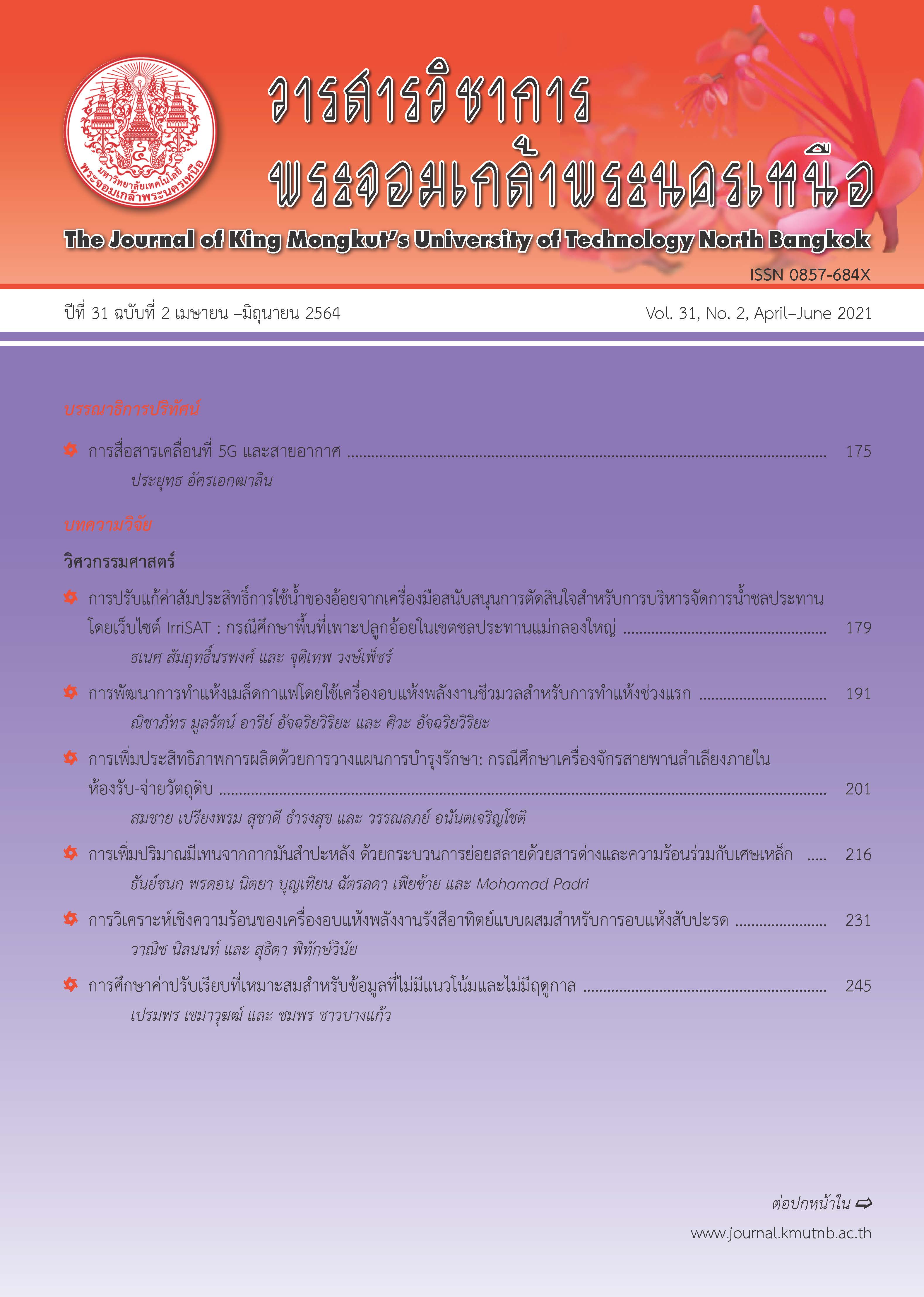ช่วงความเชื่อมั่นแบบภาวะน่าจะเป็นโพรไฟล์สำหรับพารามิเตอร์ของการแจกแจงปัวซงในการแจกแจงปัวซงค่าศูนย์เฟ้อ
Main Article Content
บทคัดย่อ
ข้อมูลจำนวนนับถูกพบได้ทั่วไปในหลายสถานการณ์ และมักนิยมใช้การแจกแจงปัวซงในการอธิบายการเกิดเหตุการณ์ที่สนใจ แต่ในบางเหตุการณ์ ค่าสังเกตศูนย์เกิดขึ้นเกินกว่าที่จะถูกพิจารณาว่ามีการแจกแจงปัวซงตามปกติได้ หนึ่งในการแจกแจงความน่าจะเป็นที่นิยมมากที่สุดที่ถูกประยุกต์ใช้กับข้อมูลที่มีลักษณะดังกล่าว คือ การแจกแจงปัวซงค่าศูนย์เฟ้อ (ZIP) ในการทบทวนวรรณกรรม งานวิจัยส่วนใหญ่เน้นไปที่พารามิเตอร์ของการแจกแจงแบร์นูลลีซึ่งเป็นส่วนประกอบหนึ่งของ ZIP ในงานวิจัยนี้จึงได้เสนอ การประมาณค่าแบบช่วงของพารามิเตอร์ของการแจกแจงปัวซงใน ZIP เมื่อพารามิเตอร์ของการแจกแจงแบร์นูลลีไม่ทราบค่า โดยใช้ฟังก์ชันภาวะน่าจะเป็นโพรไฟล์กำจัดพารามิเตอร์รบกวน โดยการศึกษาจะแบ่งออกเป็น การพิสูจน์ทางคณิตศาสตร์ และการศึกษาเชิงจำลอง การวัดประสิทธิภาพของช่วงจะพิจารณาจากค่าความน่าจะเป็นคุ้มรวม (CP) และความยาวเฉลี่ย (AL) ของช่วงโดยวิธีมอนติคาร์โล ผลการศึกษาพบว่า โดยภาพรวม ช่วงที่เสนอขึ้นให้ค่า CP ใกล้เคียงกับสัมประสิทธิ์ความเชื่อมั่นที่ต้องการ และเมื่อค่าที่แท้จริงของพารามิเตอร์ของการแจกแจงปัวซงมีค่าเพิ่มมากขึ้น ช่วงที่นำเสนอมีประสิทธิภาพดีถึงแม้ตัวอย่างมีขนาดเล็ก
Article Details
บทความที่ลงตีพิมพ์เป็นข้อคิดเห็นของผู้เขียนเท่านั้น
ผู้เขียนจะต้องเป็นผู้รับผิดชอบต่อผลทางกฎหมายใดๆ ที่อาจเกิดขึ้นจากบทความนั้น
เอกสารอ้างอิง
[2] D. Lambert, “Zero-inflated Poisson regression, with an application to defects in manufacturing,” Technometrics, vol. 34, no. 1, pp. 1–14, 1992.
[3] J. P. Boucher, M. Denuit, and M. Guillen, “Number of accidents or number of claim? An approach with zero-inflated Poisson models for panel data,” The Journal of Risk and Insurance, vol. 76, no. 4, pp. 821–846, 2009.
[4] D. Böhning, E. Dietz, P. Schlattmann, L. Mendonça, and U. Kirchner, “The zero-inflated Poisson model and the decayed, missing and filled teeth index in dental epidemiology,” Journal of the Royal Statistical Society, vol. 162, no. 2, pp. 195–209, 1999.
[5] S. Beckett, J. Jee, T. Ncube, S. Pompilus, Q. Washington, A. Singh, and N. Pal, “Zero-inflated Poisson (ZIP) distribution: Parameter estimation and applications to model data from natural calamities,” Involve a Journal of Mathematics, vol. 7, no. 6, pp. 751–767, 2014.
[6] Y. S. Wagh and K. K. Kamalja, “Zero-inflated models and estimation in zero-inflated Poisson distribution,” Communications in Statistics – Simulation and Computation, vol. 47, no. 8, pp. 2248–2265, 2018.
[7] M. Xie, B. He, and T. N. Goh, “Zero-inflated Poisson model in statistical process control,” Computational Statistics & Data Analysis, vol. 38, no. 2, pp. 191–201, 2001.
[8] J. Vandenbroek, “A score test for zero inflation in a Poisson-distribution,” Biometrics, vol. 51, no. 2, pp. 738–743, 1995.
[9] A. H. El-Shaarawi, “Some goodness-of-fit methods for the Poisson plus added zeros distribution,” Applied and Environmental Microbiology, vol. 49, pp. 1304–1306, 1985.
[10] W. G. Cochran, “Some methods for strengthening the common tests,” Biometrics, vol. 10, pp. 417– 451, 1954.
[11] C. R. Rao and I. M. Chakravarti, “Some small sample tests of significance for a Poisson distribution,” Biometrics, vol. 12, pp. 264–282, 1956.
[12] S. Numna, “Analysis of extra zero counts using zero-inflated Poisson models,” M.S. thesis, Department Science in Mathematics and Statistics., Songkla University, Songkla, Thailand, 2009.
[13] K. Paneru, R. N. Padgett, and H. Chen, “Estimation of zero-inflated population mean: A bootstrapping approach,” Journal of Modern Applied Statistical Methods, vol. 17, no. 1, 2018.
[14] P. Thongchomphu and T. Mayureesawan, “The confidence interval of the coefficient of variation for a zero-inflated Poisson, distribution,” The Journal of KMUTNB, vol. 29, no. 4, pp. 652–666, 2019 (in Thai).
[15] P. Srisuradetchai and S. Junnumtuam, “Wald confidence intervals of the parameter in a bernoulli component of zero-inflated Poisson and zero-altered Poisson models with different link functions,” Science & Technology Asia (STA), vol. 25, no. 2, pp. 1–14, 2020 (in Thai).
[16] R. A. Fisher, Statistical Methods and Scientific Inference. New York: Macmillan, 1973.
[17] S. S. Wilk, “The large sample distribution of the likelihood ratio for testing composite hypotheses,” Annals Mathematical Statistics, vol. 9, no. 1, pp. 60–62, 1938.
[18] L. Held and D. S. Bové, Applied Statistical Inference in Likelihood and Bayes, 1st ed. London: Springer, 2014.
[19] K. Soetaert and P. M. Herman, A Practical Guide to Ecological Modelling. Using R as a Simulation Platform, Springer, 2009.
[20] K. Soetaert, RootSolve: Nonlinear Root Finding, Equilibrium and Steady-state Analysis of Ordinary Differential Equations, R package 1.6, 2009.
[21] World Health Organization. (2020, October 12). WHO Coronavirus Disease (COVID-19) Dashboard Available: https://covid19.who.int/
[22] W. Zhang, J. Wang, F Qian, and Y. Chen, “A joint mean-correlation modeling approach for longitudinal zero-inflated count data,” Brazilian Journal of Probability and Statistics, vol. 34, no. 1, pp. 35–50, 2020.

